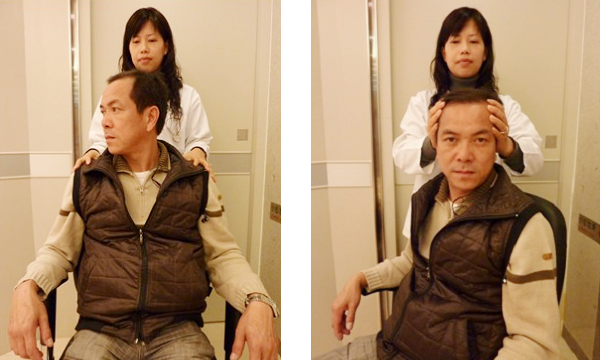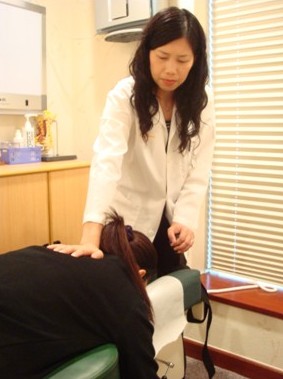
Cervicogenic dizziness
Case Sharing
Miss Yao, 47, started to feel dizzy frequently since August 2009. At first she thought it was a cold, but it didn’t improve after taking the medicine. Later, she was referred to the Otorhinolaryngology Department for a diagnosis of Meniere’s Disease and was given an anti-motion sickness medicine. The symptoms of dizziness improved greatly after taking the medicine, but the feeling of dizziness reappeared after she stopped taking the medicine.
Later, she was referred to the orthopedics department for MRI scans of the brain and cervical spine, and MRA of the brain and neck. Except for the slight disc protrusion in C5,6 and C6,7 of the neck, no pathological reasons were found. They then gave more anti-sickness medicine and muscle relaxation medicine to control the condition. In December, the symptoms of dizziness still existed, and she started to feel numbness in her hands. Sometimes feeling dizzy when neck moved into different direction, feeling like her walking is unsteady.
After detailed nerve reflex test, muscle and joint range of motion tests, and balance test, she was diagnosed with Cervicogenic Dizziness.
Case Analysis
There are many reasons for dizziness. A detailed medical history must be taken, and conditions other than cervical spondylosis must be ruled out through multiple physical examinations in order to get an accurate diagnosis. Ms. Yao’s illness is caused by long-term wrong posture and work tension that trigger cervical spine degeneration, disc protrusion, neck muscle stiffness and cervical spine misalignment. Since the neck muscles and joints are one of the important systems for maintaining the balance of the body, if the cervical spine is out of alignment, it will mistakenly send information about the physical activity to the brain. The brain thinks that the body is still active, causing the patient to feel dizzy.
Balance Test
This test can simply distinguish that dizziness is caused by cervical spine or inner ear problems. Start by sitting the patient on the revolving chair, put their hands on the armrests of the chair, and then rotate the head left and right. If the patient has dizziness, the next test is the doctor will hold the patient’s head to keep it steady and ask the patient to swing their feet left and right, if the patient continues to have dizziness, this is caused by the cervical spine. Because the patient’s head is pressed firmly and the inner ear balance is not affected, the patient’s dizziness is not caused by Meniere Disease.
(Left picture) Sit the patient on the revolving chair, put his hands on the armrest of the chair, and then turn the head left and right.
(Picture on the right) The next test is to hold the patient’s head, the patient swing left and right with both feet. If the patient continues to have dizziness symptoms, this is dizziness caused by the cervical spine.
Treatment of cervical disc disease causing dizziness-Cox® decompression therapy
Mainly use Manual therapy to correct misaligned vertebrae, and then cooperate with chiropractic treatments and ultrasound to relax muscles and increase blood circulation in the affected area. However, when some patients come to see a doctor, dizziness is very serious that cannot manipulated with manual therapy, they may also have more dizziness or headache after manual therapy.
Therefore, Cox® decompression therapy can gently increase the activity of the cervical spine and relax the muscles, and increase blood circulation to the brain. After the patient’s symptoms are improved, it can be corrected with Manual therapy, which can be easily accepted by the patient and can greatly reduce the side effect after treatment. When the patient’s dizziness disappears, continue to treat the cervical spine disease, correct the patient’s posture, and cooperate with stretching and strengthening the neck muscles.

Cox® decompression therapy can gently increase the movement space of the cervical spine and relax the muscles
The difference between vertigo and dizziness
Patients usually confuse the symptoms of dizziness and vertigo, but there is a difference between the two;
Vertigo : The patient has the sensation of spinning around, feeling the surrounding things are spinning.
Dizziness: The patient does not have a strong sense of spinning, feels heavy head and walking unsteadily, and often cannot mind focus.
How should we maintain balance in our body?
To maintain body balance, our brain must coordinate the information from our eyes, muscles and joints, and inner ears. Dizziness is mostly related to inner ear problems, but if there is a problem with one of the following systems that control the balance of the human body, it can cause dizziness.
1) Inner ear: Basic body balance control
2) Brain: transmit information to and from the body
3) Eyes: sense body position and surrounding environment
4) Touch: Feeling the things around us
5) Muscles and joints: transmit physical activity to the brain

 Book an Appointment
Book an Appointment


